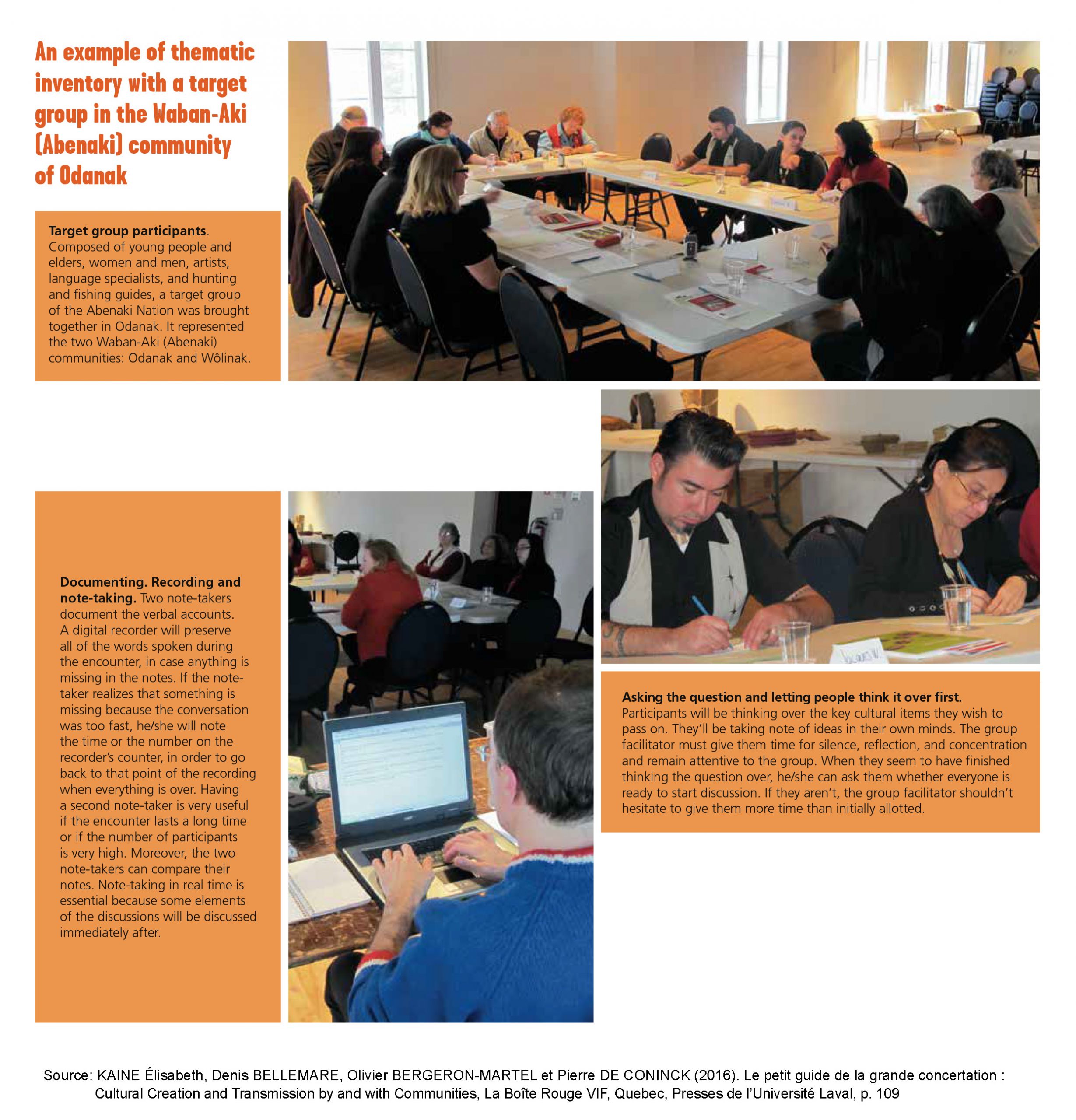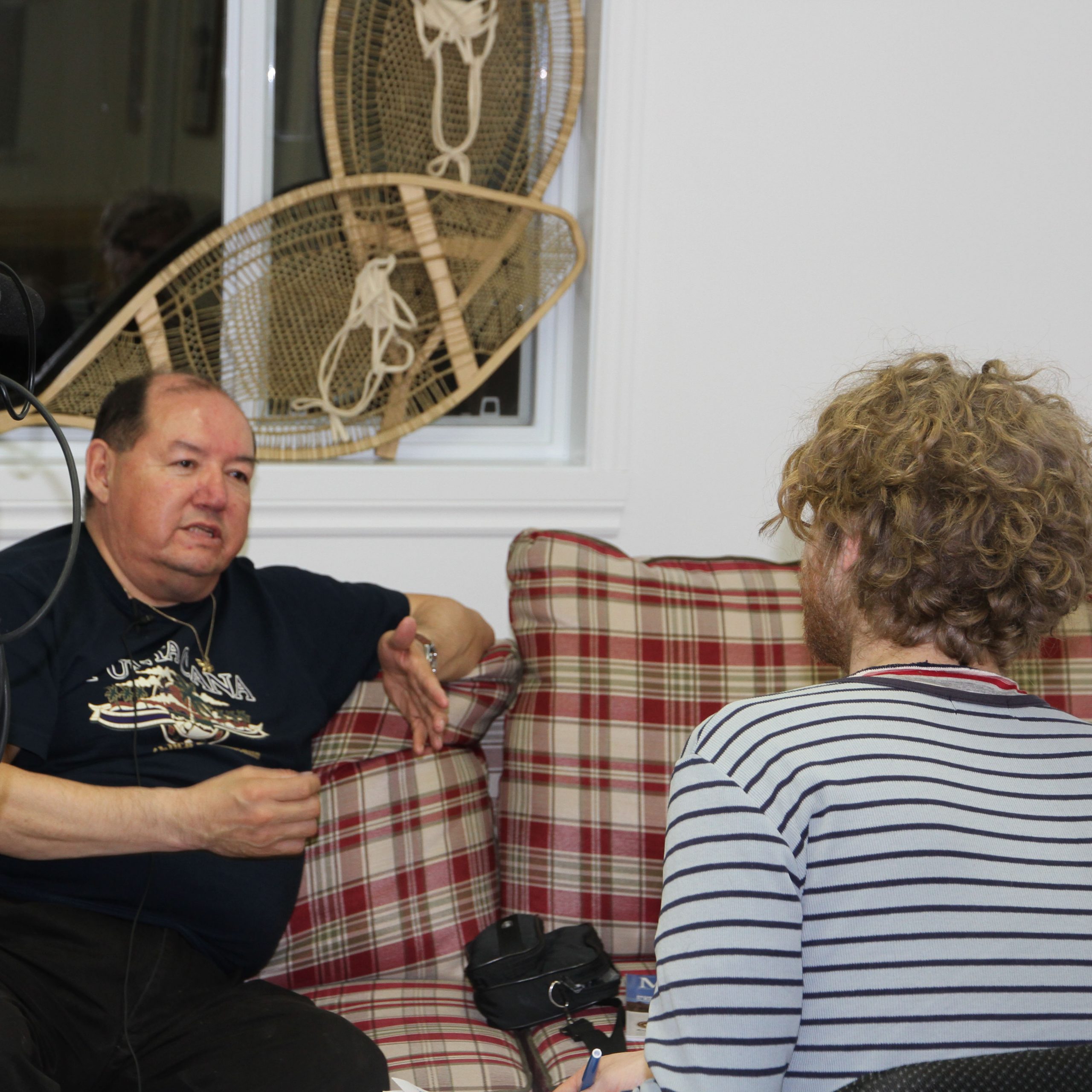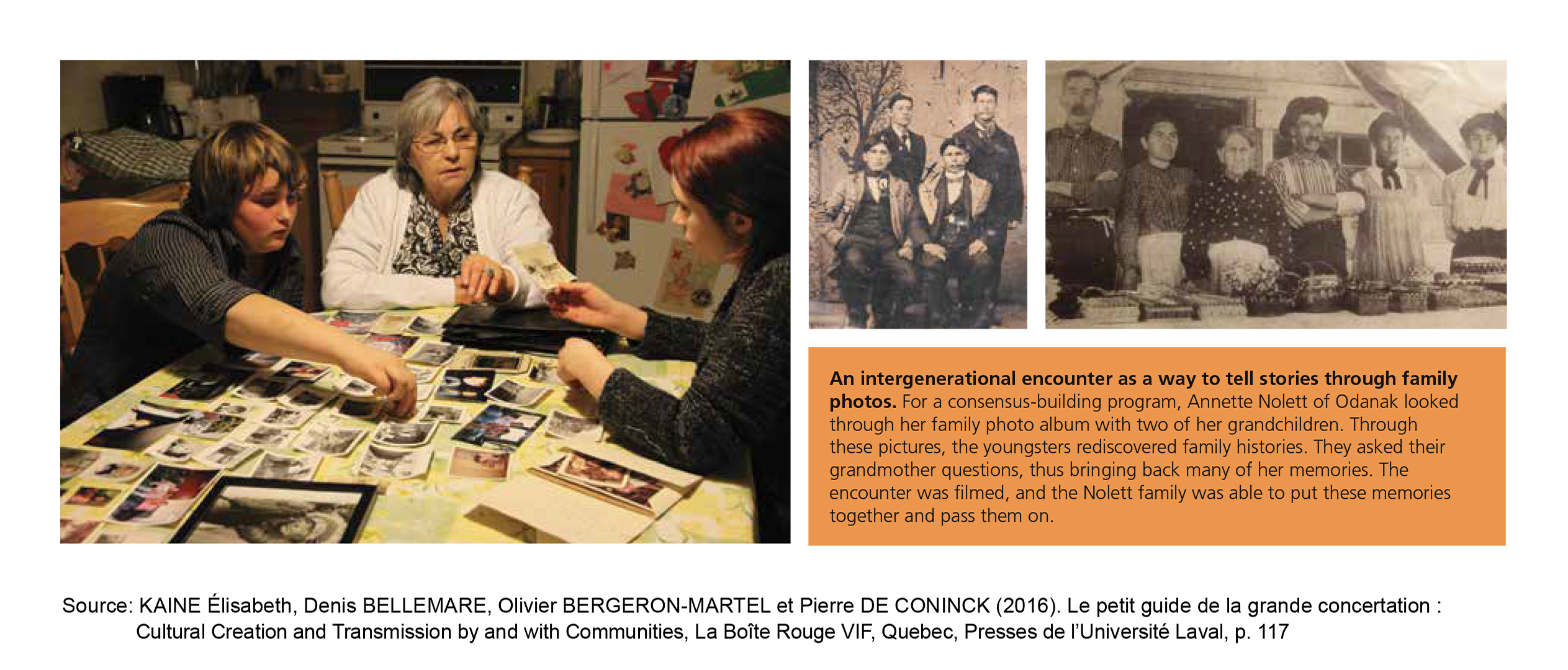Thematic analysis with a focus group
One of the first steps of a consultation is often the thematic analysis with a focus group. This activity helps identify various perspectives of the same topic and provides guidelines for further development.
Objectives
- To establish an overview of a situation.
- To obtain different points of view.
- To encourage exchanges and the complementarity of viewpoints.
- To generate topics and provide suggestions for further research.
Development process
PRIOR
1. Form a group of about 12 people.
Groups can be smaller or larger, depending on the context.
2. Define the profile of the participants.
Depending on the context and the objectives, it is important to define the profile of the participants. It is generally preferable to form a group with individuals of various ages, genders, families and professional backgrounds.
3. Prepare questions.
It is a good idea to focus on a simple, general, open-ended question that can be broken down into sub-questions to address various perspectives or different publics. Here is a sample question:
Name elements of your history that you consider important, which need to be transmitted...
- to the youth in your community?
- to people in your community?
- to Allochthonous people?
DURING
1. Plan for someone to be the facilitator and someone else to take notes in real-time.
Suggested materials: table, digital recorders and paper, cards and pencils.
Note: The recorders are used to capture the meeting. The recordings obtained can be used to complete the notes, if necessary. However, participants should be advised, as some Elders may be reluctant to being recorded.
Procedure
- Once the cards and pencils have been distributed, the facilitator asks the questions;
- The facilitator gives the participants about 15 minutes to answer each question;
- Participants take turns explaining their answers, this encourages discussion among the group;
- Once the round table is concluded, participants share their cards and, collectively categorize their ideas according to the themes to be defined as a group (more precisely, combine what goes together and identify these groups).
SUBSEQUENTLY
1. Complete all notes, ensuring that all the statements have been transcribed correctly and consistently.
2. Return all notes to the participants so that their statements can be validated. They can elaborate on an idea or ask for certain statements to be removed.
Option 1
The activity can be performed using photographs or objects. Thus, instead of answering in writing, participants can choose photos or objects at their disposal.
Option 2
Questions may be asked beforehand, and participants may be asked to supply the necessary material for the meeting.
Examples of practice
Downloadable tool
Discussion workshop regarding tangible heritage: archival photographs, objects, etc.
This workshop can be held among a community group, a family group or during individual interviews. Tangible heritage helps to revive memory. It encourages the expression of historical experience and facilitates exchanges and dialogue. Elders particularly like this type of activity.
Objectifs
- To reveal human interest stories.
- To document and collect views on past events.
- To document a specific know-how, location or aspect.
- To select people and/or situations that had a historical impact.
Development process
PRIOR
1. Identify items of tangible heritage that are relevant to the intent of the research project.
This tangible heritage can come from different sources. Personal or family heirlooms or photographs may be used. Conducting research in community, provincial or museum archives may be useful. Many museums provide online access to their collections. Photographs of objects may be useful during the workshop.
Option 1
A meeting in the presence of objects from museum collections can be organized in partnership with a museum institution.
Option 2
Workshop participants may be asked to bring photographs, objects, or other elements of their tangible and cultural heritage that they wish to share.
DURING
1. Encourage spontaneous and open discussion.
Discussion flows freely. Spontaneous questions may be asked as they come up to ensure understanding and to further develop documentation.
2. Offer all participants the opportunity to speak.
The facilitator ensures that all participants of a group have the opportunity to speak. It is recommended to record or take notes on what is said during the meeting. Photographs or video footage may also be taken to capture what was said during the meeting.
SUBSEQUENTLY
1. Share all material stemming from the meeting.
It is important to provide participants with the transcripts, photographs and videos for their personal archives and for content validation. This will ensure the consistency of the archived material.
Note : During meetings, it is important to demonstrate understanding regarding the choice of language used. If participants are more comfortable speaking in their native language, the use of an interpreter is recommended, to facilitate dialogue when necessary.
Examples of practices
The Maison de la culture innue of Ekuanitshit. Discussion workshop with Elders from the community to identify and document objects and photographs from the museum collection in order to integrate them into a book on the history of the community.
Downloadable tool
Individual and group interviews
There are several ways of conducting individual and group interviews. For the proposed approach, the informal interview and the semi-structured interview are recommended since they enable the collection of content based on experience and nuanced narrative, the sensitivity and revelation of others.
Objectives
- To document knowledge, experiences, and ways of doing and being.
- To encourage conscientious and culturally meaningful documentation.
Development process
PRIOR
1. Determine the goals, objectives, intentions and key points to be addressed.
The key is not to have an answer for each item, but to clearly state the general objectives of what is being sought.
2. Present the meeting’s objectives to the participants and jointly plan how the interview will proceed.
DURING
1. Prepare and set up the material.
Once time has been taken to set up and prepare the material, no further thought needs to dwell on the matter. It is important to check the proper functioning of the recording and to have a list of technical items to be verified, such as cleaning the lens. This approach helps in the heat of the moment.
2. Ask open-ended questions that invite discussion, exchanges and sharing.
During the interview, it is recommended to ask open-ended questions that invite descriptions and details to be disclosed. It is preferable to avoid questions that generate short, closed-ended answers (yes or no), such as questions that begin with “Would...”.
3. Develop questions in such a way that participants will include these questions in their responses.
It may be useful to ask questions in such a way that participants include these questions in their responses. This approach makes it easier to use the recordings when producing a means for transmission and/or an educational agent. Examples of questions: What should one know about this topic? What would you like to tell the youth?
4. Do not interrupt participants.
This is, of course, a matter of respect, but not interrupting participants also facilitates eventual dissemination.
SUBSEQUENTLY
1. Share all material stemming from interviews.
It is important to provide participants with transcripts, photographs and videos for their personal archives and for content validation. This will ensure the consistency of the archived material.
For further development...
Qualitative or quantitative, structured, semi-structured or informal interviews
There are various methods of conducting interviews. In the proposed approach, we favour the qualitative interview which is conducted in a semi-structured manner. It encourages the expression and development of thought. It enables further documentation of cultural and intangible nuances by identifying feelings, impressions and ways of thinking and acting.
The informal interview is another approach for collecting qualitative content. It is particularly used when demonstrating observable skills. In this situation, the interviewer is more of an observer, and the interviewee is encouraged to share knowledge and demonstrate what he or she desires.
In some circumstances, gathering quantitative content may be a necessary requirement of collection. Quantitative methods are mainly used to provide a statistical and representative portrait of certain characteristics of a theme. They involve asking specific questions that are not open to interpretation and to which the answers are very short (a single or a few words, a rating scale of 1 to 5, etc.). The interview is essentially directed and leaves little room for emotion. Quantitative collection is generally used to reach a large number of participants. Telephone or online surveys are most commonly used.
Practical online tool available to create surveys
Google Forms This tool from Google helps develop forms which can be sent remotely to gather responses from selected individuals. It can also be used for other purposes, such as the creation of registration forms.
Downloadable tool
PDF file
Playful workshop with youth
The products for transmission and education developed from content of consultations are often addressed to young people, who are rarely involved in the consultation phase. Why not involve them during the research phase? Their interests and knowledge can certainly guide the collection process. Since it is not always easy to establish a dialogue with this age group, here are some ideas to make the meeting fun and enriching...
Objectives
- Listen to the opinion of young people regarding their historical and cultural interests.
- Guide the consultation and collection process towards topics of interest for young people.
- Determine the needs in terms of transmission and education.
Suggestions for activities
Game-quiz: To encourage dialogue and conversation among youth. Young people can discuss together by asking questions from cards just like a quiz format. A camera can be made available to the youth to record the meeting. They should ask the selected questions in a style like a television interview.
Photovoice2
This activity must be carried out in two stages.
1. Young people are asked to take pictures of items (or people) they are curious about which come from their daily lives or culture. They should be given a few days to do this. Print or project the photographs taken and ask participants to present them.
2. Let the discussion flow freely and if needed, ask for clarification regarding the reasons or stories related to the photographs.
Note : Young people can also participate in the consultation. For instance, they may carry out activities of documentation and collection with their peers. See the section Intergenerational meetings.
2 This method was developed by Caroline C. Wang, University of Michigan, and Mary Ann Burris.
Downloadable tool
Intergenerational meetings
Creating contexts for intergenerational meetings and exchanges is a very effective and culturally significant method of consultation and collection, especially when dissemination and transmission of this content is addressed to a young public.
- To give young people the opportunity to seek information and document topics and elements that interest them.
- To give Elders the opportunity to transmit to young generations the information they consider important.
- To encourage cultural transmission between Elders and youth.
- To initiate an intergenerational dialogue.
- To value young people and encourage them to get involved in the transmission of their culture.
PRIOR
1. Raise awareness about the importance of documenting one's history and culture.
2. Give young people basic notions for collection and documentation.
(see the section Documentation practices)
3. Discuss with the youth the topics and/or historical and cultural elements they would like to discuss with an Elder.
4. Support the youth in the preparation and organization of an intergenerational meeting: selection of an Elder, initiating contact, logistical, technical and material preparation, etc.
DURING
1. Be available remotely, if needed.
SUBSEQUENTLY
1. View or listen to the recordings with the youth and provide feedback for improvement, as needed.
2. Ensure that the data is archived and that copies are sent to the participants.
Note: The concept “intergenerational” should be interpreted in its broad sense. A parent-child meeting can be just as relevant as a meeting with an Elder.
Practice example
Excerpt from meeting territory:
“Meeting Territory” Project Fall 2020
Video clip filmed by Jennifer Launière, Mashteuiatsh
Downloadable tool
Open-line
An open-line is generally addressed to the whole community. It allows for one or more questions to be discussed. It invites people of the community to express themselves on air. An open-line requires the collaboration of community radio.
Objectives
- To acquire the outlook of the community regarding history or a certain topic.
- To provide research leads to document history or a certain topic.
- To rally a community on the subject of history or a common theme.
Development process
PRIOR
1. Promote the activity and clearly communicate the objectives.
2. Develop a well-defined question.
3. Provide an experienced facilitator to lead the discussions.
4. Provide someone who is familiar with the research topic to offer clarification, if needed.
DURING
1. Host the open-line, while ensuring the collection objective.
2. Record and/or take notes of the open-line and the contact information of participants.
SUBSEQUENTLY
1. Consolidate the notes taken.
2. Follow up with participants in the event that more elaborate discussions may be needed for collection.
Practice example
Tipatshimu / Innu Takuaikan Uashat mak Mani-Utenam
Since the summer of 2020, La Boîte Rouge VIF has been supporting the education sector of Innu Takuaikan Uashat mak Mani-Utenam (ITUM) in a documentation and development project concerning the history of the community's management of education. During the last few months, several research activities have taken place in various existing archives (local, provincial and federal). In addition, interviews have been and will be conducted with the living memories of the community. An open-line on the community radio has been set up to inform the population and to allow them to contribute to this project which is of great importance and a source of pride for the community. In the upcoming year, we will begin the co-creation of permanent devices for development and transmission that will highlight the result of this research.
Downloadable tool
Vox pop
An interview can be intimidating, thus the proposed “vox pop” method allows participants to express themselves freely, without the pressure of someone watching them or being asked an unexpected question.
Objectives
- To encourage freedom of expression.
- To provide a comfortable, pressure-free context for expression.
Development process
PRIOR
- Provide an adequate location (soundproof, without any people-traffic, with a background and some lighting, etc.) to set up a comfortable recording area.
- Prepare a question or a few questions for people to answer.
- If the activity is not held within the framework of an event, provide the necessary promotion.
- Provide technical guidance to activate recordings.
DURING
- Have someone greet participants and provide them with directions.
- Provide technical verifications between each recording.
SUBSEQUENTLY
- Ensure that the data is archived and that copies are sent to participants.


















